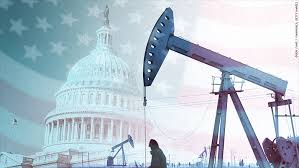Oil prices drop on concerns about patchy demand recovery, record U.S. stocks

Oil prices fell by about 4% on Thursday on worries about slow demand growth as coronavirus cases rise, with U.S. crude stockpiles hitting an all-time high and the U.S. Federal Reserve saying recovery from the pandemic could take years.
The sun is seen behind a crude oil pump jack in the Permian Basin in Loving County, Texas, U.S., November 22, 2019. REUTERS/Angus Mordant
Brent crude LCOc1 futures fell 3.4%, or $ 1.42, to $ 40.31 a barrel by 0600 GMT, erasing Wednesday’s gains. Earlier in the session, Brent was down as much as $ 1.53, or 3.7%.
U.S. West Texas Intermediate (WTI) crude CLc1 dropped 4%, or $ 1.60, to $ 38 a barrel, after being down earlier as much as $ 1.69, or 4.3%.
U.S. crude inventories rose unexpectedly by 5.7 million barrels in the week to June 5 to 538.1 million barrels – a record – as imports were boosted by the arrival of supplies bought by refiners when Saudi Arabia flooded the market in March and April, data from the Energy Information Administration (EIA) showed.
The effect of the Saudi import surge on pricing should be “transitory”, said Jeffrey Halley, market analyst at OANDA.
“Nevertheless, in the short-term, oil looks vulnerable to a downside correction to thin out weak longs,” he said.
EIA data also showed gasoline stockpiles grew more than expected to 258.7 million barrels. Distillate stockpiles, which include diesel and heating oil, rose by 1.6 million barrels, but the increase was smaller than in previous weeks.
The market took a negative view on the stock builds, even though there were signs of improving gasoline demand as well, said Commonwealth Bank commodities analyst Vivek Dhar.
“Most of the (price) gains have come from when strict lockdowns were lifted. Coming back to where it was pre-COVID – that will take some time,” Dhar said.
Adding to the negative sentiment, the U.S. Federal Reserve said in its first projections of the pandemic era that the world’s largest economy would shrink by 6.5% this year, with the unemployment rate at 9.3% at the end of 2020.
“Short-term and fast money traders are very much inclined to sell outright or to take profits on any hint of bearish data,” said Stephen Innes, chief global market strategist at Axicorp.
In a further sign recovery will continue to be overshadowed by the coronavirus, total U.S. cases topped 2 million on Wednesday, with new infections rising slightly after five weeks of declines, according to a Reuters analysis.

